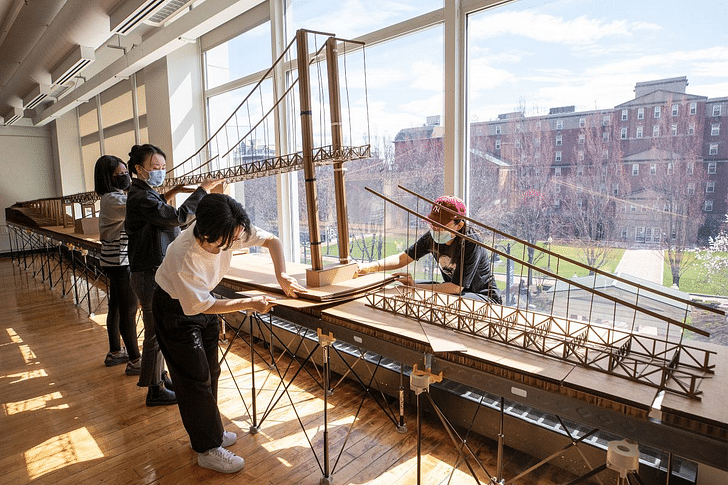

The case for increased accessibility for pedestrians and cyclists is an ongoing topic. While public access and mobility within urban landscapes also involve factors relating to public policy and urban planning, eight students from RISD's Interior Architecture (RISD Int|AR) were presented with a challenge to address ways an iconic bridge in Rhode Island could be improved.
For their project "Crossing the Pell," a group of graduate students has developed a design proposal that brings attention to pedestrian and cyclist pathways to Pell Bridge, an iconic suspension bridge connecting Newport and Jamestown, RI.
"Crossing the Pell" is merely one of the many projects produced by students from RISD's Int|AR program that aims to elevate the use and application of adaptive reuse techniques and community engagement. To learn more about this work, Archinect explores the project and the immersive in-person exhibition that took place in August.
*The RISD Department of Interior Architecture’s MA in Adaptive Reuse program is a one-year post-professional degree for architects to focus on the reuse of structures. The spring Adaptive Reuse Studio and the related Adaptive Reuse Seminar are the culmination of the program.
This year’s Crossing the Pell studio is co-taught by Michael Grugl, Andrew Hartness, Wolfgang Rudorf, and Liliane Wong.
Our goal was to help acclimate the public to something new using virtual reality to create an immersive 3D experience. — Liliane Wong
The iconic bridge was completed in 1969 and renamed the Claiborne Pell Bridge after longtime Rhode Island State senator Claiborne de Borda Pell. The bridge's massive steel-framed suspension, which connects Jamestown and Newport, measures 2.1 miles long and rises to a peak that reaches 400 feet off the water. This structural feat allowed for Navy aircraft carriers to pass underneath the roadbed below. This also allowed motorists crossing the bridge to experience magnificent views of Narragansett Bay.
However, during the bridge's 50th anniversary, Rhode Island Senator Sheldon Whitehouse and other local government leaders inquired if bridge access could be improved not only for pedestrians and cyclists but by re-routing access on the Newport side of the bridge.
This inquiry led Liliane Wong, RISD Int|AR's department head and graduate studio instructor, to challenge her students and their real-world applications of adaptive reuse. "Proposing change to an icon like the Pell Bridge is difficult," she explained. "Our goal was to help acclimate the public to something new using virtual reality to create an immersive 3D experience." Thanks to the guidance of Professor Wong, along with faculty members Michael Grugl, Andrew Hartness, and Wolfgang Rudorf, eight graduate students developed a way to address these changes.
Eight graduate students spanning across the MA and MLA program at RISD formed two cross-disciplinary teams that helped develop design strategies that not only provided increased access and usability but implement improved public space venues. To accomplish this, the students addressed several factors. From wind conditions, sea-level rise, and feasible construction materials, the students developed a comprehensive design strategy to address a design that incorporated social equity, feasibility, and responsible environmental impacts.
Students Demi Okunfulure and Mohan Wang proposed a system that would "harness solar and wind energy via photovoltaic and piezoelectric components to power the bridge's lights as well as 275 homes." They explained that this method was a "holistic approach to the future of bridge design that captures energy through infrastructure."
Students Nupoor Maduskar and Yu Xiao focused on the area's historical fisheries. They developed an idea of creating a floating fish market and a series of "floating eco-islands along the span that would create new habitats for fishes and spur a new type of fishing tourism. The project pays homage to the state's fishing economy by incorporating an architectural vocabulary of nets that play with natural elements such as light, wind, and gravity."
In the hope of boosting the local economy, students Saira Margarita Paz Nepomuceno and Seung Hwan Oh propose a tourism-focused design strategy that includes a welcome center, "docking points for sailboats, and a spectacular outdoor theater on the bridge viewable from a new floating amphitheater." At the same time, students Sofia Paez and Shuyi Guan addressed high winds with "an enclosed 3D printed structure made out of carbon fiber and wrapped in a translucent composite membrane."
This past May, the design studio presented their proposed design ideas to Whitehouse's team in an immersive experience using cardboard VR googles and Pano software. This preview of the bridge's design possibilities led to the students receiving funding from the Champlin Foundation. This funding allowed the studio to present their work and in an immersive exhibition in August.
"Whatever the long-term outcome of their proposals, I couldn't be more proud of the students in this class," shared Wong when discussing the exhibition and its reception from the community. The exhibition's goal was to provide local citizens, and government leaders with details and visual resources where the design elements proposed could be considered and implemented. “As the culminating learning experience in a post-professional program, the studio supports RISD’s commitment to sustainability—a pillar of our strategic plan—and pushed them to consider real-life parameters such as communities divided by economic disparity, the threat of sea-level rise, and the positive and negative effects of tourism on the city. These are exactly the kinds of issues that successful professionals contend with in practice.”
To learn more about RISD's Int|AR program and offerings click here.
Katherine is an LA-based writer and editor. She was Archinect's former Editorial Manager and Advertising Manager from 2018 – January 2024. During her time at Archinect, she's conducted and written 100+ interviews and specialty features with architects, designers, academics, and industry ...
No Comments
Block this user
Are you sure you want to block this user and hide all related comments throughout the site?
Archinect
This is your first comment on Archinect. Your comment will be visible once approved.